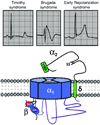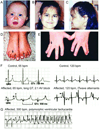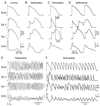Phenotypical manifestations of mutations in the genes encoding subunits of the cardiac voltage-dependent L-type calcium channel
- PMID: 21372292
- PMCID: PMC3056572
- DOI: 10.1161/CIRCRESAHA.110.224279
Phenotypical manifestations of mutations in the genes encoding subunits of the cardiac voltage-dependent L-type calcium channel
Abstract
The L-type cardiac calcium channel (LTCC) plays a prominent role in the electric and mechanical function of the heart. Mutations in the LTCC have been associated with a number of inherited cardiac arrhythmia syndromes, including Timothy, Brugada, and early repolarization syndromes. Elucidation of the genetic defects associated with these syndromes has led to a better understanding of molecular and cellular mechanisms and the development of novel therapeutic approaches to dealing with the arrhythmic manifestations. This review provides an overview of the molecular structure and function of the LTCC, the genetic defects in these channels known to contribute to inherited disorders, and the underlying molecular and cellular mechanisms contributing to the development of life-threatening arrhythmias.
Figures





Similar articles
-
Mutations in voltage-gated L-type calcium channel: implications in cardiac arrhythmia.Channels (Austin). 2018;12(1):201-218. doi: 10.1080/19336950.2018.1499368. Channels (Austin). 2018. PMID: 30027834 Free PMC article. Review.
-
Mutations in the cardiac L-type calcium channel associated with inherited J-wave syndromes and sudden cardiac death.Heart Rhythm. 2010 Dec;7(12):1872-82. doi: 10.1016/j.hrthm.2010.08.026. Epub 2010 Oct 14. Heart Rhythm. 2010. PMID: 20817017 Free PMC article.
-
Severe arrhythmia disorder caused by cardiac L-type calcium channel mutations.Proc Natl Acad Sci U S A. 2005 Jun 7;102(23):8089-96; discussion 8086-8. doi: 10.1073/pnas.0502506102. Epub 2005 Apr 29. Proc Natl Acad Sci U S A. 2005. PMID: 15863612 Free PMC article.
-
Inherited calcium channelopathies in the pathophysiology of arrhythmias.Nat Rev Cardiol. 2012 Oct;9(10):561-75. doi: 10.1038/nrcardio.2012.93. Epub 2012 Jun 26. Nat Rev Cardiol. 2012. PMID: 22733215 Review.
-
Phenotypical manifestations of mutations in the genes encoding subunits of the cardiac sodium channel.Circ Res. 2011 Apr 1;108(7):884-97. doi: 10.1161/CIRCRESAHA.110.238469. Circ Res. 2011. PMID: 21454796 Review.
Cited by
-
L-type Calcium Channel Cav1.2 Is Required for Maintenance of Auditory Brainstem Nuclei.J Biol Chem. 2015 Sep 25;290(39):23692-710. doi: 10.1074/jbc.M115.672675. Epub 2015 Aug 4. J Biol Chem. 2015. PMID: 26242732 Free PMC article.
-
L-type Ca2+ channels in heart and brain.Wiley Interdiscip Rev Membr Transp Signal. 2014 Mar 1;3(2):15-38. doi: 10.1002/wmts.102. Wiley Interdiscip Rev Membr Transp Signal. 2014. PMID: 24683526 Free PMC article.
-
Pathophysiology of Calcium Mediated Ventricular Arrhythmias and Novel Therapeutic Options with Focus on Gene Therapy.Int J Mol Sci. 2019 Oct 24;20(21):5304. doi: 10.3390/ijms20215304. Int J Mol Sci. 2019. PMID: 31653119 Free PMC article. Review.
-
Calcium Channels in the Heart: Disease States and Drugs.Cells. 2022 Mar 10;11(6):943. doi: 10.3390/cells11060943. Cells. 2022. PMID: 35326393 Free PMC article. Review.
-
Cellular and ionic mechanisms underlying the effects of cilostazol, milrinone, and isoproterenol to suppress arrhythmogenesis in an experimental model of early repolarization syndrome.Heart Rhythm. 2016 Jun;13(6):1326-34. doi: 10.1016/j.hrthm.2016.01.024. Epub 2016 Jan 25. Heart Rhythm. 2016. PMID: 26820510 Free PMC article.
References
-
- Chen X, Zhang X, Kubo H, Harris DM, Mills GD, Moyer J, Berretta R, Potts ST, Marsh JD, Houser SR. Ca2+ influx-induced sarcoplasmic reticulum Ca2+ overload causes mitochondrial-dependent apoptosis in ventricular myocytes. Circ Res. 2005;97:1009–1017. - PubMed
-
- Fleckenstein A. History of calcium antagonists. Circ Res. 1983;52:I3–I6. - PubMed
-
- Mangoni ME, Traboulsie A, Leoni AL, Couette B, Marger L, Le Quang K, Kupfer E, Cohen-Solal A, Vilar J, Shin HS, Escande D, Charpentier F, Nargeot J, Lory P. Bradycardia and slowing of the atrioventricular conduction in mice lacking CaV3.1/alpha1G T-type calcium channels. Circ Res. 2006;98:1422–1430. - PubMed
Publication types
MeSH terms
Substances
Grants and funding
LinkOut - more resources
Full Text Sources
Medical

